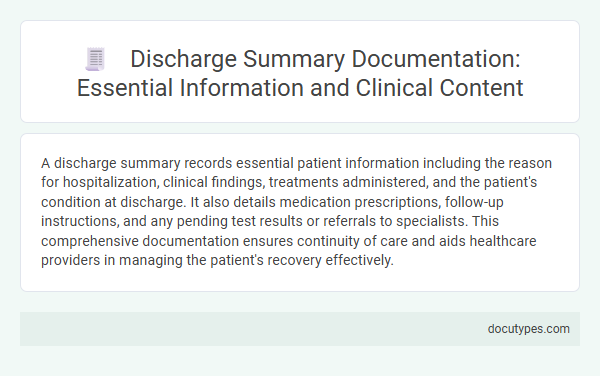A discharge summary records essential patient information including the reason for hospitalization, clinical findings, treatments administered, and the patient's condition at discharge. It also details medication prescriptions, follow-up instructions, and any pending test results or referrals to specialists. This comprehensive documentation ensures continuity of care and aids healthcare providers in managing the patient's recovery effectively.
Introduction to Discharge Summary Documentation
A discharge summary is a concise medical document that outlines a patient's hospital stay and care provided. It serves as a critical communication tool between healthcare providers during the transition from inpatient to outpatient care.
This summary typically includes patient identification, admission and discharge dates, and primary diagnoses. It records treatments administered, procedures performed, and medications prescribed during hospitalization. Additionally, it provides recommendations for follow-up care and patient instructions to ensure continuity of treatment.
Importance of Accurate Discharge Summaries
A discharge summary records critical information such as the patient's medical condition at admission and discharge, treatments administered, medications prescribed, and follow-up care instructions. Accurate discharge summaries ensure continuity of care, reduce the risk of medical errors, and support effective communication between healthcare providers. Your well-documented discharge summary is essential for safeguarding patient safety and facilitating optimal recovery.
Key Components of a Discharge Summary
What types of information are recorded in a discharge summary? A discharge summary captures essential details about your hospital stay to ensure continuity of care. Key components include patient identification, admission and discharge dates, and the reason for hospitalization.
Which medical events are detailed in a discharge summary? It records the diagnosis, treatments administered, surgical procedures, and any complications encountered. This information helps healthcare providers understand your medical history thoroughly.
How is medication information presented in a discharge summary? The summary lists all medications prescribed during your stay and those recommended after discharge. It includes dosages, administration routes, and any changes made to your medication regimen.
What follow-up care instructions are included in a discharge summary? Detailed recommendations about post-discharge care, such as follow-up appointments, dietary guidelines, and activity restrictions, are provided. This guidance supports your recovery and prevents readmission.
Is patient condition at discharge documented in the summary? Yes, it specifies your condition at the time of discharge, including physical status and any ongoing symptoms. This section helps monitor your progress after leaving the hospital.
Patient Identification and Administrative Details
Discharge summaries include essential patient identification and administrative details to ensure accurate medical record-keeping and continuity of care. These details facilitate communication between healthcare providers and support efficient patient management.
- Patient Name and Date of Birth - These identifiers confirm the patient's identity and differentiate them from others with similar names.
- Medical Record Number - A unique number assigned to each patient for tracking clinical information and hospital visits.
- Admission and Discharge Dates - Dates marking the patient's hospital stay period, critical for treatment timelines and insurance purposes.
Hospital Course and Clinical Summary
| Types of Information Recorded in a Discharge Summary | |
|---|---|
| Hospital Course | This section details the progression of the patient's condition during hospitalization. It includes diagnostic tests performed, treatments administered, response to therapies, complications encountered, and significant changes in clinical status. Hospital course documents the rationale behind medical decisions, interventions, and adjustments to the care plan. |
| Clinical Summary | The clinical summary provides a concise overview of the patient's presenting illness, admission diagnosis, and key findings from physical examination and laboratory results. It summarizes the medical reasoning that guided treatment decisions and outlines the patient's condition at the time of discharge. This portion helps ensure continuity of care by informing healthcare providers about your hospital stay and clinical progress. |
Medications at Discharge
A discharge summary includes critical details about the medications prescribed to a patient at the time of hospital discharge. This information ensures continuity of care and helps prevent medication errors during post-discharge treatment.
- Medication List - A comprehensive list of all prescribed medications, including dosages and administration schedules, is documented to guide ongoing therapy.
- Changes to Medications - Any adjustments made to pre-admission medications, including discontinuations or new prescriptions, are clearly noted.
- Instructions and Warnings - Specific instructions regarding medication use, potential side effects, and monitoring requirements are provided to inform the patient and outpatient providers.
Follow-Up Instructions and Appointments
Discharge summaries include detailed follow-up instructions to guide your care after leaving the hospital. These instructions often specify medication schedules, dietary recommendations, and activity restrictions to ensure proper recovery.
Appointments for future consultations or diagnostic tests are clearly outlined to maintain continuity of care. This information helps coordinate ongoing treatment with your primary care provider or specialists.
Communication with Primary Care Providers
A discharge summary records essential patient information, including diagnosis, treatment provided, and follow-up care instructions. This document ensures continuity of care by offering a clear overview for primary care providers.
Communication with primary care providers involves detailed notes on medication changes, pending test results, and recommended outpatient services. Accurate and timely information supports effective patient management and reduces the risk of readmission.
Common Pitfalls in Discharge Summaries
A discharge summary records critical information such as patient demographics, diagnosis, treatment provided, and follow-up instructions. Common pitfalls include incomplete medication lists, vague follow-up plans, and missing test results. Accurate, detailed discharge summaries enhance continuity of care and reduce readmission risks.
What Types of Information Are Recorded in a Discharge Summary? Infographic

